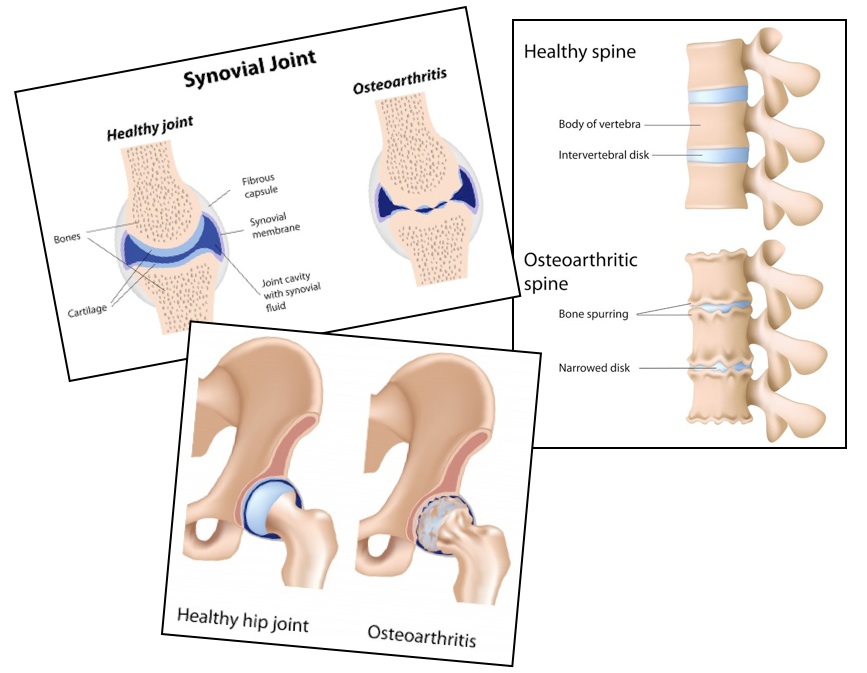Osteoarthritis

Tips for Helping Relieve Osteoarthritis.
- Physical Therapists can help to reduce the symptoms of OA and educate you on the proper exercises to perform.
- Low impact cardiovascular exercise such as cycling, elliptical machines and swimming will help to lubricate and loosen the joint.
- Your doctor can prescribe anti-inflammatory medications.
- Perform appropriate strength-building exercises at least 3x per week.
- Losing weight will reduce the amount of stress and strain placed on the joint during every day activities.
Understanding and Treating Osteoarthritis
Millions of Americans suffer pain, stiffness, loss of flexibility and swelling in their joints. These symptoms often accompany the most common form of arthritis known as Osteoarthritis (OA). Often referred to “wear and tear arthritis” in layman’s terms, it impacts the hands, neck, lower back, knees, hips and other joints. Osteoarthritis can be debilitating for some people and drastically change the quality of their life.
While joint damage from OA worsens over time and cannot be cured, it can be treated. Every day Physical Therapists successfully treat patients with osteoarthritis. Many patients can have an active lifestyle and avoid significant changes to their functional level with a rehabilitation program designed specifically for them.
An Osteoarthritis (OA) Primer
OA causes pain, stiffness and other symptoms in the joints. A quick overview of joints will help clarify the condition known as OA.
Healthy Joints Allow Motion and Withstand Stress
When two or more bones come together, they form a joint. The joint is designed to allow motion and withstand the normal stress and strain of life’s activities without experiencing damage. Moving joints require minimal friction when the bones move upon themselves. These moving joints are known as Synovial Joints. They have a viscous fluid inside, providing lubrication.
The ends of the bones are covered with a smooth articular cartilage (Hyaline cartilage), which helps to reduce the friction produced when the joint moves. These joints are held together or encapsulated by a fibrous, leather –like “bag” that engulfs the ends of the bones. This capsule is firmly attached to the bones. The capsule provides an anchoring system for tendons of muscles and adds stability to the joint in all directions. When the joints are healthy, individuals can freely engage in a range of activities and motions.
Damaged Joints May Cause Pain and Inhibit Movement
If the joint is subjected to too much sheer or compression force, damage can occur. Since the damage to the joint is often due to the cumulative effect of these forces, it can develop and worsen over time.
When the force is too great, the Hyaline cartilage could be crushed or “sheered-off.” If this happens, the cartilage does not have the ability to “heal” or re-generate. Over time, this cartilage can continue to deteriorate and may eventually be gone in the damaged area. Once this happens, the “raw” bone underneath is exposed, and severe pain may occur when the area comes in contact with another part of the joint.
When the Hyaline cartilage is damaged, the natural shape of the joint changes and the fibrous capsule changes too. The capsule is stretched or shortened in response to the changed shape of the ends of the bones. The capsule can “pull” on the bone, and this stimulates the bone to produce more bone or a bone spur. Unfortunately, the bone spur can be in an area that “touches” something else and produces pain or more damage to other structures of the joint.
Weight bearing joints such as hips, knees and back (lumbar spine) are most commonly damaged by compression or sheer force of life’s activities. At the same time, any moving joint can experience damage and develop OA.
Treating and Managing Osteoarthritis
If you experience stiffness, pain or swelling in your joints for more than a couple of weeks, schedule an appointment with your Physical Therapist. Your Physical Therapist is trained to treat OA in every part of the body and can design a rehabilitation program specifically for you. The primary goal of the program should be to restore the function of the joint by reducing pain, increasing range of motion and strength. While the exercises cannot “cure” or “heal” the damaged structures of the joint, they can slow down the progression of the damage.
Exercises, stretching and other modalities, can increase strength and efficiency of muscle contraction, enabling the muscle to control the joint and reduce the stress and strain on the bones. Patients who follow a proper regimen can move more freely with less pain, returning to many of the activities in life they enjoy.

























good description
Good job